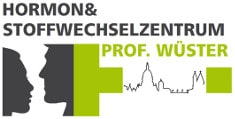Bone metabolism disorders
Hereditary diseases with multiple symptoms
Hypophosphataemic rickets
In this hereditary disease (also called “phosphate diabetes”), affected individuals excrete excessive amounts of phosphate through the urine. As a result, growing bones remain soft and deformed. The first signs of the disease can be seen as early as two to three months after birth. The anamnesis is followed by a blood pressure measurement, ECG and a hearing test. The height is also compared with the growth curve of healthy children.
The following symptoms can occur:
- Increased FGF23 serum level
- Curved legs and leg deformities (from the age of 2)
- Abnormal growth of the cranial bones
- Conspicuous head shape (asymmetrically long skull shape, lateral flattening, bulging forehead, widening of the bone sutures)
- Malalignment of the knee joints (X-/O-legs)
- Waddling, wide-legged gait
- Frequent bone fractures and pain
- Osteoarthritis due to bone malpositions
- Muscle weakness
- Shortened body parts
- Early growth retardation
- Impaired tooth development, tooth abscesses, paradontosis
- Sensorineural hearing loss
Possible diagnostic procedures:
- Determination of relevant serum levels (phosphate, alkaline phosphatase, vitamin D3)
- Urine tests
- Molecular biological tests
- Bone density measurement using DXA
- Determination of bone age by radiography
- X-rays
- MRT
- Sonography of the kidneys
- Heart echo (for people with high blood pressure)
Possible therapeutic measures:
- Medicinal (including for vitamin D metabolism, calcium, antibody build-up)
- Physical (treat muscle weakness, improve coordination and mobility)
- Surgical (take care of skeletal deformities)
- Orthopaedic (treat severe bone deformities)
- Dental treatments
- ENT treatments
Hypophosphatasia
Hypophosphatasia (also called “Rathbun’s syndrome”) is a rare, hereditary, non-curable metabolic disorder that is usually diagnosed in infancy and is caused by a genetic mutation. In hypophosphatasia, alkaline phosphatase (extremely important for bone formation) is insufficiently produced. The disease manifests itself in various ways, and the symptoms are non-specific. However, there are four types of hypophosphatasia, depending on age: perinatal, infantile, juvenile and adult. In the special form of odonto-hypophosphatasia, there is premature loss of the (milk) teeth.
The following symptoms may occur:
- Rickets-like symptoms (including waddling gait, x-/o-legs)
- Conspicuous short stature
- Recurrent fatigue fractures
- Poor healing of fractures
- Bone marrow oedema (abnormal accumulation of fluid)
- Muscle and bone pain
- Pathological remodelling processes in the bones
- Conspicuous early loss of milk teeth, maldevelopment of dentition
- Periodontosis, conspicuous problems with caries, tooth anomalies
- Pathological deposits in the joint, mineralisation of the joint cartilage, joint pain
- Tendonitis, calcification and adhesions, rheumatism
- Diarrhoea, constipation, malaise due to intolerances
- Depression, headaches, anxiety disorders, insensitivity
- Kidney stones, kidney weakness, insufficiency and calcification
Possible diagnostic procedures:
- Bone density measurement using DXA
- X-rays
- Bone scintigraphy
- MRT
- Nuclear medicine examinations
- Molecular biological examinations
Laboratory tests (e.g. calcium, phosphate, vitamin B6) - Examination of bone remodelling markers
It is also important to find out whether the patients have a thyroid disease, suffer from anaemia or bone malformations. Is there dangerous copper accumulation with associated functional disorders of the liver, central nervous system, eyes and/or kidneys (Wilson’s disease)? Is the vitamin deficiency disease scurvy also present? Can overweight operations be responsible for certain values? Is there a severe magnesium deficiency? Are certain contraceptives being taken?
Possible therapeutic measures:
A (long-term) enzyme replacement therapy replaces the alkaline phosphatase that is genetically missing. This therapy can alleviate many of the symptoms mentioned of Bone metabolism disorders. Drug therapy with non-steroidal anti-inflammatory drugs, osteoporosis therapeutics and vitamin D is also possible. Heat or cold therapy and physiotherapy are also recommended.

